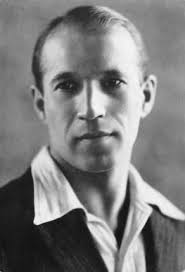

Queer Places:
Arolo, 21038 Leggiuno VA, Italia
 Cecil Arthur Lewis MC (29 March 1898 – 27 January 1997) was a British
fighter pilot who flew in World War I. He went on to co-found the British
Broadcasting Company and enjoy a long career as a writer, notably of the
aviation classic Sagittarius Rising (some scenes from which were
represented in the film Aces High).[1]
Cecil Arthur Lewis MC (29 March 1898 – 27 January 1997) was a British
fighter pilot who flew in World War I. He went on to co-found the British
Broadcasting Company and enjoy a long career as a writer, notably of the
aviation classic Sagittarius Rising (some scenes from which were
represented in the film Aces High).[1]
Educated at Oundle School, Lewis joined the Royal Flying Corps in 1915 after lying about his age[2] and learned to fly at Brooklands. In 1916, he flew the Morane Parasol in combat with No. 3 Squadron and was awarded the Military Cross[3] for his actions during the Battle of the Somme.[4] Flying over the battlefield on the First day on the Somme (1 July 1916) to report back on British troop movements, Lewis witnessed the blowing of the mines at La Boiselle. He later described the early morning scene in his book "Sagittarius Rising": "We were to watch the opening of the attack, coordinate the infantry flare (the job we have been rehearsing for months) and stay over the lines for two and a half hours". It had been arranged that continuous overlapping patrols would fly throughout the day. Lewis' patrol was ordered "to keep clear of La Boiselle" because of the mines that were to be blown. As he watched from above the village of Thiepval, almost two miles from where the mines exploded, Lewis saw a remarkable sight: "At Boiselle the earth heaved and flashed", he wrote, "a tremendous and magnificent column rose up into the sky. There was an ear-spitting roar, drowning all the guns flinging the machine sideways in the repercussing air. The earthly column rose, higher and higher to almost four thousand feet." Lewis' aircraft was hit by lumps of mud thrown out by the explosion.[5]
During May and June 1917, when he was flying the S.E.5a with No. 56 Squadron, Lewis was credited with eight victories.[6] Back in England, Lewis served with No. 44 and No. 61 Squadrons on Home Defence before returning to France in late 1918 with No. 152 (Night-Fighter) Squadron, flying the Sopwith Camel, and serving as a flight commander with the rank of captain.[7] A 40-minute interview with Lewis, describing his experiences as a World War I pilot was recorded by the BBC in 1963 -64 and made available online as part of the World War I centenary commemorations.[8] In it, he described how on his first flight he had the most unusual experience of seeing 9 inch howitzer shells turning over in flight at 8000 feet before descending to the target. He also described his most frightening experience of the war—reconnaissance at 1000 feet during the initial bombardment prior to the battle of the Somme. This entailed flying along the line of fire of shells. Close passing shells caused severe turbulence to the aircraft and a number of his friends were killed.[8]
After the war, Lewis was hired by the Vickers company to teach the Chinese how to fly and to establish a Peking–Shanghai air service using Vickers Commercials, the civilian version of the Vickers Vimy bomber. It was in Peking that Lewis married Doushka Horvath (1902–2005), the daughter of a Russian general.[9] Lewis returned to England when the air service project was abandoned by Vickers after a couple of years.
Through his friend, the Russian singer Vladimir Rosing, Lewis met the artist Charles Ricketts, who became his artistic mentor and sponsor. After Ricketts' death, Lewis edited his letters and journals for publication.
Lewis was one of the five young men who, in 1922, founded the British Broadcasting Company (precursor of the British Broadcasting Corporation) where he was a writer, producer, and director.[10] (The other founders were John Reith, Arthur Burrows, Stanton Jefferies and Peter Eckersley.) In 1931, he co-wrote and directed a short film adaptation of the George Bernard Shaw play How He Lied to Her Husband. In late 1936–early 1937 he was a producer and presenter for the infant BBC Television Service at Alexandra Palace.[11] At the 1938 Academy Awards ceremony, Lewis, Shaw, Ian Dalrymple and W. P. Lipscomb were awarded Oscars for their screen adaptation of Pygmalion.[12]
Lewis joined the Royal Air Force Volunteer Reserve in early 1939 as a pilot officer,[13] and during World War II served in Sicily, Greece, Egypt, and Italy, rising to the rank of squadron leader.[14]
During the late 1940s Lewis became enamoured with the teachings of the Greek-Armenian mystic Gurdjieff. In 1947 he flew a Miles Gemini to South Africa, where he spent the next three years on a farm he established, but the farm was not a success, and in 1950 he returned to England. He joined the Daily Mail in 1956 as a reporter.
After his retirement he moved to Corfu where he spent the rest of his life, continuing to write until well into his nineties.
He was the last surviving British flying ace of World War I. George Bernard Shaw wrote of Lewis: "This prince of pilots has had a charmed life in every sense of the word. He is a thinker, a master of words and a bit of a poet."[15]
My published books:
... How old are you?' 'Almost eighteen, sir.' (Liar! You were seventeen last month.) ...